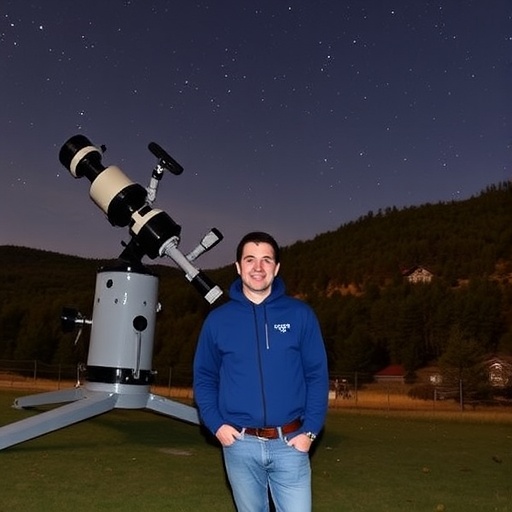In the quest to unravel the mysteries of dark energy—a force thought to make up approximately 70% of the universe and drive its accelerating expansion—scientists are leveraging advanced technology to enhance the capabilities of radio telescopes. One such innovator, Kevin Bandura, an engineer and associate professor at West Virginia University, is pioneering methods to improve the calibration of radio telescopes. This technological enhancement is crucial as it allows astronomers to glean valuable information about the universe’s expansion by measuring neutral hydrogen, a fundamental element with no electric charge.
Bandura’s role in this cutting-edge research places him at the forefront of the Canadian Hydrogen Intensity Mapping Experiment (CHIME) and a newly established radio telescope project known as the Canadian Hydrogen Observatory and Radio-transient Detector (CHORD). Both projects aim to investigate the cosmic web—a vast structure woven from galaxies and intergalactic space, shaped intricately by dark energy. By focusing on the “21-centimeter signal”—a specific wavelength emitted by neutral hydrogen—Bandura is enhancing our understanding of the universe’s structure and its underlying physics.
The 21-centimeter signal is the key to unlocking a deeper comprehension of the universe’s large-scale patterns and formations. As neutral hydrogen collects along the strands of the cosmic web, understanding its distribution could provide crucial insights into dark energy’s role in shaping the cosmos. Bandura’s work includes developing sophisticated signal processing techniques designed to improve the detection capabilities of radio telescopes and reduce noise from nearby radio wave sources, which could otherwise obscure the faint signals from distant hydrogen atoms.
Bandura emphasizes the importance of precise calibration techniques for radio telescopes, stating, “We’re developing a new technique to measure the telescopes’ response to the sky and reduce uncertainties so we can better measure dark energy.” This method is vital for extracting meaningful data, allowing for more accurate assessments of how dark energy influences the universe’s expansion. The new calibration sources will leverage an innovative chip developed by Bandura, which can be airborne—utilized not just on telescopes but also deployed via drones.
The collaboration among researchers, including those from Yale University and Canadian astronomers, has contributed to the development of a new radio calibrator source that utilizes this chip. With its fast and efficient design, this calibrator source is capable of providing a strong signal-to-noise ratio, which is vital for the rigorous calibration required to detect subtle cosmic signals. Bandura’s team aims to enhance this technology further, expanding its bandwidth and stability, thereby improving its functionality when used simultaneously across multiple telescope arrays.
As Bandura and his colleagues progress with their research, they are not merely focused on the technical aspects; they are also invested in creating educational outreach programs. Undergraduate students involved in the research will spearhead the development of a mobile radio receiver lab designed for high school and community college classrooms across West Virginia. This initiative will provide hands-on technical experience and insight into radio astronomy while fostering early interest in STEM fields among younger demographics.
The ambitious project is underpinned by financial backing from the National Science Foundation, which has allocated significant grants to support Bandura’s research endeavors. These funds facilitate the exploration of advanced radio astronomy techniques and bolster the development of tools that analyze the 21-centimeter signals more robustly. Bandura’s work aims to unveil baryon acoustic oscillation signals to attain a clearer understanding of the space between galaxies and the dynamics of dark energy.
The overarching goal of Bandura and his team’s research is to have the CHIME telescope independently detect distinctive patterns in the large-scale structure of the universe. This will involve meticulous measurements that can illuminate the vast and intricate web of cosmic structures, examining how dark energy contributes to the ongoing expansion of the universe since the Big Bang.
By positioning themselves at the helm of this groundbreaking research, Bandura and his colleagues are not only advancing our understanding of fundamental cosmic forces but also inspiring the next generation of scientists. The work being conducted at West Virginia University demonstrates the intersection of engineering and cosmology, highlighting the potential for innovative technological solutions to solve some of the most profound questions regarding our universe’s nature and origins.
As these advancements unfold and new techniques for detecting cosmic signals are developed, the implications extend beyond just dark energy; they redefine our understanding of the universe itself. Bandura’s commitment to calibrating radio telescopes represents a pivotal step toward illuminating the hidden facets of dark energy and, in turn, the very fabric of the cosmos.
Continued efforts within this research space promise new discoveries that could alter our perceptions of astrophysical phenomena and deepen our understanding of the universe’s expansive nature. As astronomers collaborate to decode the signals emitted by the cosmos, the unfolding story of dark energy remains a captivating area of exploration that holds the potential to reshape contemporary astrophysics profoundly.
Subject of Research: Enhancing Radio Telescopes for Dark Energy Measurement
Article Title: A New Frontier in Understanding Dark Energy
News Publication Date: October 2023
Web References: WVU Research, NSF Awards
References: CHIME Telescope Research
Image Credits: WVU Photo/Brian Persinger
Keywords
Dark Energy, Radio Telescopes, CHIME, Cosmic Web, 21-Centimeter Signal, Signal Processing, WVU, Cosmology, Educational Outreach, NSF Grants.




